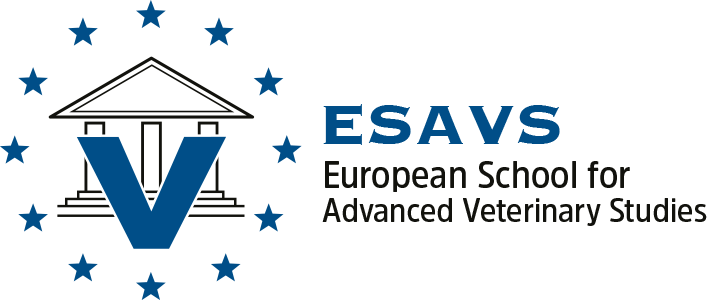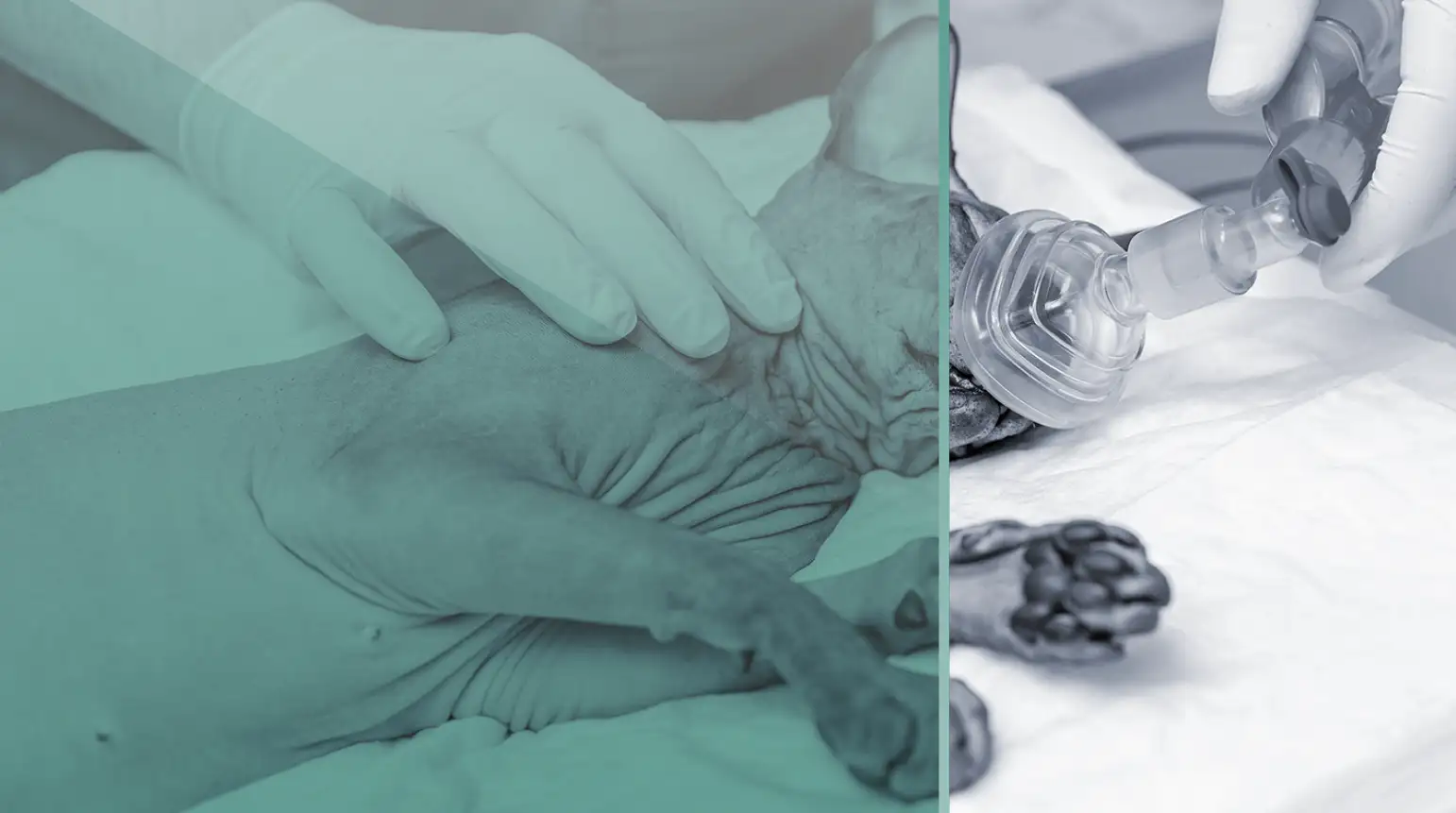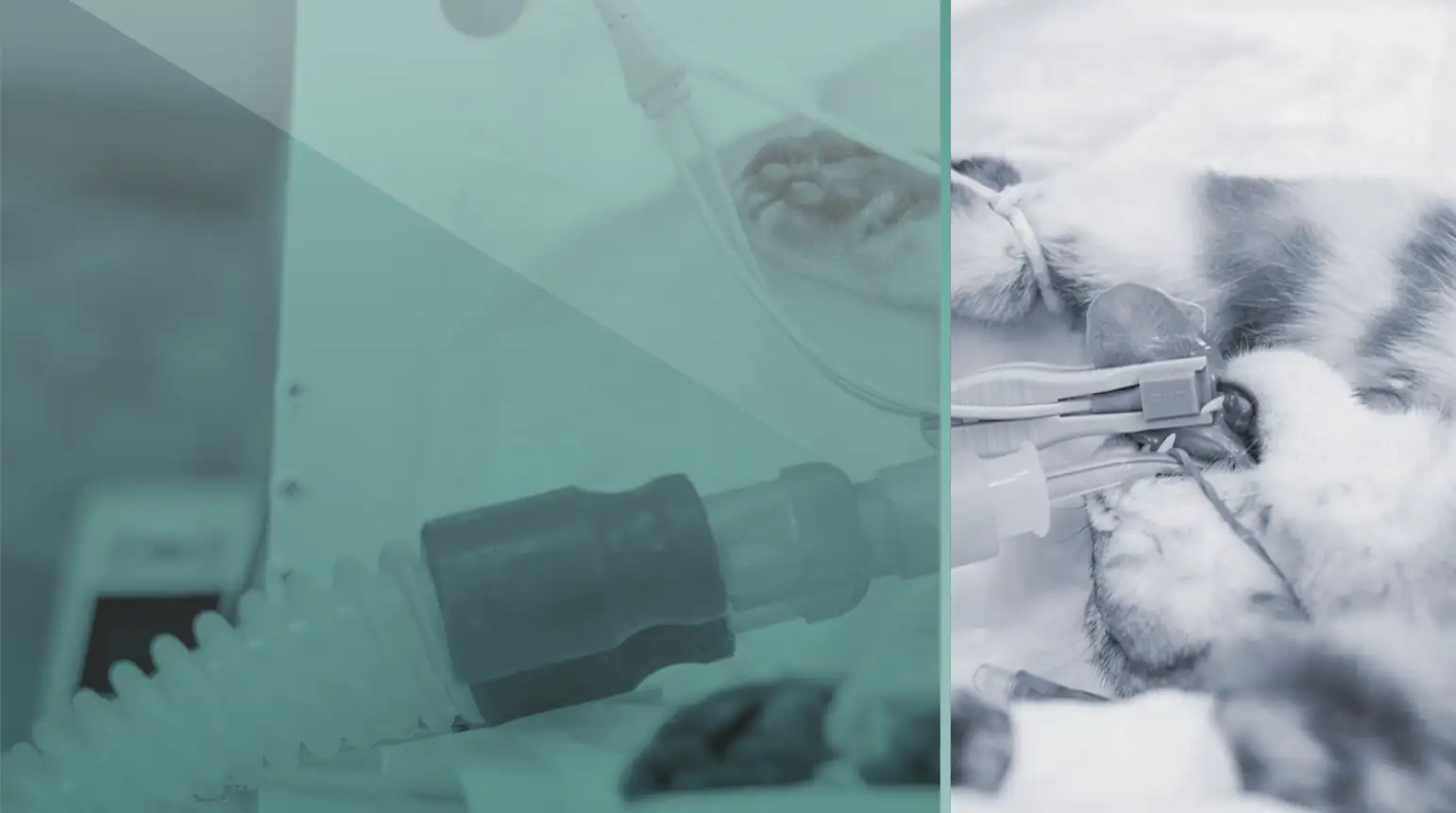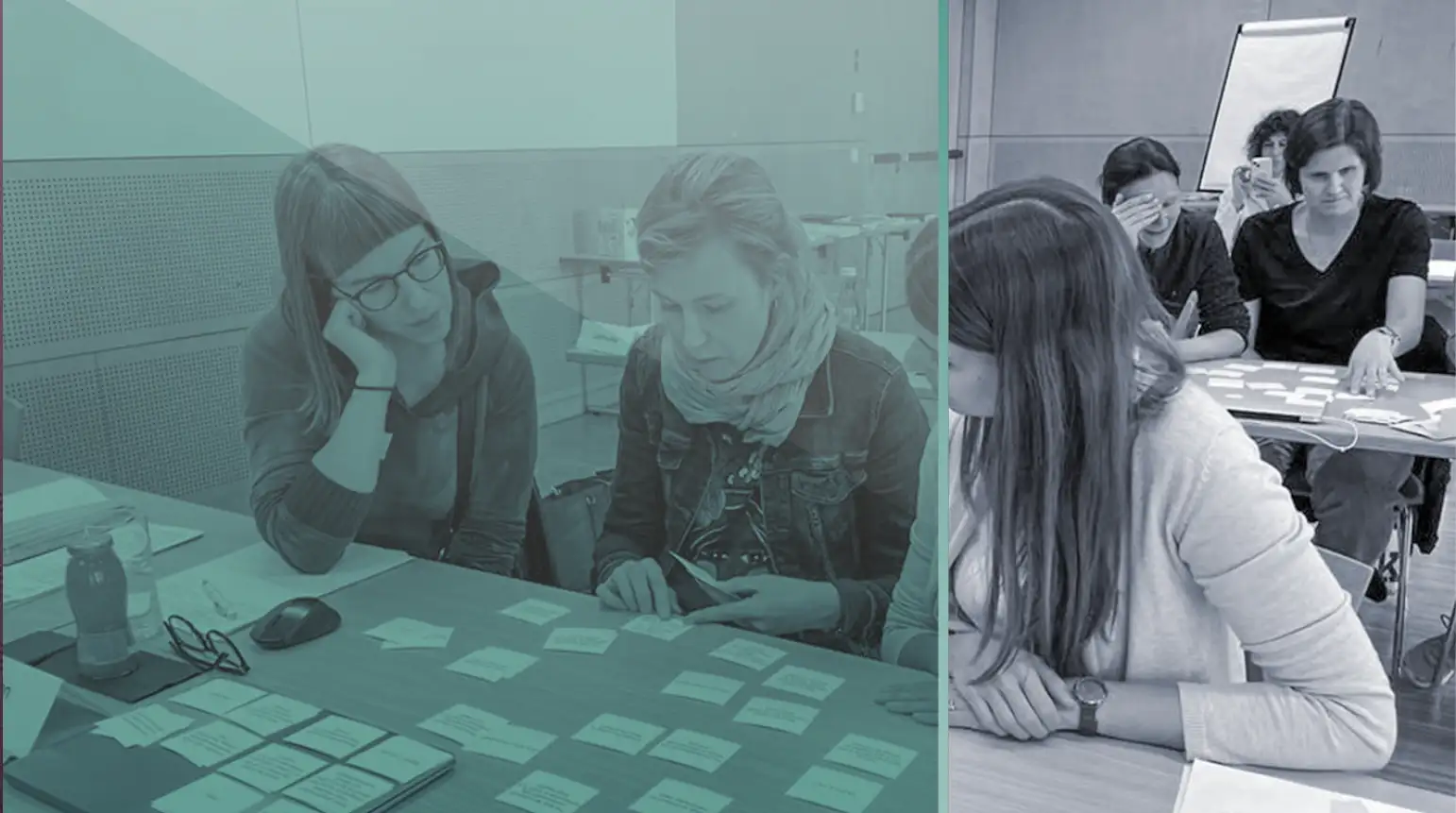Veterinary Technician
Veterinary Technician Certificate Course In Principle Techniques Of Small Animal Anesthesia, Perioperative Analgesia & Critical Patient Care
Principal Course Master:
Lecturers:
Dr. Chiara Adami, Dipl. ACVAA, Dipl. ECVAA
Dr. Sandra Allweiler, Dipl. ACVAA
Dr. Luis Campoy, Dipl. ECVAA
Dr. Giacomo Gianotti, Dipl. ACVAA
Dr. Sabrina Höhne Dipl. ACVECC, Dipl. ECVECC
Dr. Franzika Meyer Dipl. ACVECC
Course Overview
This ESAVS Certificate Program for veterinary nurses and technicians covers advanced education in veterinary anesthesia, analgesia, and perioperative care as necessary to satisfy the growing expectations of both the veterinary community and animal owners. The course program is directed towards licensed animal health technicians/nurses with focused interest in small animal anesthesia, analgesia, and perioperative care and potentially the desire to pursue in the future a career as veterinary technician specialist (VTS) in anesthesia & analgesia.
The 3-module course combines traditional methods of lecturing and laboratory/workshop teaching with the new technology of in-person online and on-demand e-learning. Furthermore, it offers the opportunity to obtain certification in basic and advanced techniques of cardiopulmonary resuscitation from the International Veterinary Emergency & Critical Care Society (Recover Initiative).
This Certificate Program has already been validated and accredited by:
– AVA (Association of Veterinary Anaesthetists);
– ACVAA (American College of Veterinary Anesthesia and Analgesia);
– IVECCS (International Veterinary Emergency & Critical Care Society (Recover Initiative)).
Please note: It is mandatory to pass exams in order to obtain the Certificate.
Topics and excerpt of the course program:
- Introduction into the course and outline of the function of a veterinary anesthesia technician within the clinical veterinary team
- Physiological, pathophysiological & pharmacological concepts of anesthesia and perioperative analgesia in small animals
- Basic principles of safe and efficient anesthesia and perioperative pain management in small animals, ranging from pre-anesthetic patient assessment to post-anesthetic care
- Components, function, and functionality testing of anesthesia equipment and workstations
- Basic concepts of safe anesthesia techniques and methods of perioperative analgesia
- Techniques of perioperative vital function monitoring
- Basic concepts and clinically commonly applied methods for monitoring depth of anesthesia and nociception
- Disease-, age-, and species-specific aspects of anesthesia and perioperative analgesia management
- Maintenance of adequate respiratory and cardiovascular function during anesthesia
- Management of intraoperative respiratory and/or hemodynamic dysfunction
- Basic and advanced techniques of cardiopulmonary resuscitation following the RECOVER consensus guidelines including RECOVER INITIATIVE certification as Rescuer
- Recognition and management of perianesthetic cardiac arrhythmias
- Recognition and management of perianesthetic disturbances in blood, electrolyte, and/or acid-base homeostasis
- Recognition of perioperative pain and assistance in pain therapy
Course Program
Module I: Course half-days 1 – 13 (OCT 22-24 | NOV 03-05 | NOV 19-21 & DEC 02-05,2025) in Live Online ZOOM-Streaming
Wednesday, 22 October 2025
Welcome and introduction into the course (structure of the course with live-Zoom-streaming webinars, in-person classes/workshops and topics covered in the course; teaching goals; MCQ testing, inter-module work and on-demand webinars offered in-between modules). – Driessen
12:00 – 13:00 Introduction
Building a successful anesthesia service team (Functioning of an anesthesia team within the framework of legal rules, anesthesia guidelines, RVT – DVM communication requirements, and appropriate tasks of RVTs within the team). – Driessen
13:00 – 14:00 Principles of Pharmacology
Applied Pharmacodynamics for the Anesthetist (Principles of Drug Interactions with the Organism; Drug Efficacy; Drug Safety). – Driessen
14:00 – 14:30 Lunch/coffee break
14:30 15:30 Principles of Pharmacology
Applied Pharmacokinetics for the Anesthetist: Delivery, distribution & elimination of injectable agents used in anesthesia. – Driessen
15:30 – 16:30 Preanesthetic sedatives, tranquilizers, analgesics and adjuncts
Pharmacology of premedication drugs (α2-Agonists; Phenothiazines) – Part I. – Driessen
16:30 – Approx. 17:30 Preanesthetic sedatives, tranquilizers, analgesics and adjuncts
Pharmacology of premedication drugs (α2-Agonists; Phenothiazines) – Part II. – Driessen
Approx. 17:30 Adjourn
Thursday, 23 October 2025
Pharmacology of premedication drugs (Opioids). Part I. – Driessen
12:00 – 13:00 Preanesthetic sedatives, tranquilizers, analgesics and adjuncts
Pharmacology of premedication drugs (Opioids). Part II. – Driessen
13:00 – 13:30 Lunch/Coffee break
13:30 – 14:30 Preanesthetic sedatives, tranquilizers, analgesics and adjuncts
Pharmacology of premedication drugs (Benzodiazepines, Antidepressants, Anticholinergics). – Driessen
14:30 – Approx. 15:30 Injectable anesthetics
Pharmacology of injectable anesthetics ([Thiopental], Propofol, Alfaxalone, Etomidate) – Part I. – Driessen
Approx. 15:30 Adjourn
Friday, 24 October 2025
Pharmacology of injectable anesthetics ([Thiopental], Propofol, Alfaxalone, Etomidate) – Part II. – Driessen
12:00 – 13:30 Injectable anesthetics
Pharmacology of injectable anesthetics (Ketamine, Tiletamine-Zolazepam; [Opioids]) – Part III. – Driessen
13:30 – 14:00 Lunch/Coffee break
14:00 – 15:00 Maintenance of anesthesia with injectable anesthetics
Total (TIVA) & partial intravenous anesthesia (PIVA) for maintenance of anesthesia – Part I. – Gianotti
15:00 – Aprox. 16:00 Maintenance of anesthesia with injectable anesthetics
Total (TIVA) & partial intravenous anesthesia (PIVA) for maintenance of anesthesia – Part II. – Gianotti
Aprox. 16:00 Adjourn
Monday, 3 November 2025
Pharmacology of inhalant anesthetics (Isoflurane, sevoflurane, [desflurane]; N2O) – Part II. – Driessen
12:00 – 13:00 Inhalant anesthetics
Applied Pharmacokinetics for the Anesthetist: Uptake, distribution & elimination of inhalant anesthetics. – – Driessen
13:00 – 13:30 Lunch/Coffee break
13:30 – 14:30 Inhalant anesthetics
Applied Pharmacokinetics for the Anesthetist: Uptake, distribution & elimination of inhalant anesthetics – Driessen
14:30 – Aprox. 15:30 Inhalant anesthetics
Applied Pharmacokinetics for the Anesthetist: Uptake, distribution & elimination of inhalant anesthetics in the computer simulation. – Driessen
Aprox. 15:30 Adjourn
Tuesday, 4 November 2025
Principles of low and high flow anesthesia with inhalant anesthetics. – Driessen
12:00 – 13:00 Inhalant anesthetics
Demonstration in the computer simulation model: High flow/low flow anesthesia. – Driessen
13:00 – 13:30 Lunch/Coffee break
13:30 – 14:30 General anesthesia: Inhalant anesthetic equipment & techniques
Anesthesia machine, anesthesia circuits, vaporizers & related equipment – Part I. – Adami
14:30 – Approx. 15:30 General anesthesia: Inhalant anesthetic equipment & techniques
Anesthesia machine, anesthesia circuits, vaporizers & related equipment – Part II. – Adami
Approx. 15:30 Adjourn
Wednesday, 5 November 2025
Methods of endotracheal intubation & associated paraphernalia and techniques of assisted endotracheal intubation with focus on animals with difficult airways, rabbits, and other laboratory/exotic animals. – Adami
12:00 – 13:00 General anesthesia: Inhalant anesthetic equipment & techniques & SpO2 monitoring
Pulse oximetry and its pittfalls. – Adami
13:00 – 13:30 Lunch/Coffee break
13:30 – 14:30 Cardiovascular system functioning during anesthesia & hemodynamic monitoring
Physiology of the cardiovascular system & common cardiovascular monitoring techniques – Part I. – Driessen
14:30 – Approx. 15:30 Cardiovascular system functioning during anesthesia & hemodynamic monitoring
Physiology of the cardiovascular system & common cardiovascular monitoring techniques – Part II. – Driessen
Approx. 15:30 Adjourn
Wednesday, 19 November 2025
Causes and recognition of hemodynamic impairments during anesthesia. – Driessen
12:00 – 13:00 Cardiovascular system functioning during anesthesia
Principal approach to managing hemodynamic impairments during anesthesia. – Driessen
13:00 – 13:30 Lunch/Coffee break
13:30 – 14:30 Supportive care during anesthesia: Blood volume & blood component status
Recognition of abnormal perianesthetic hydration and blood volume/blood component status and common techniques of perianesthetic fluid therapy (crystalloids, colloids, blood products) – Part I. – Driessen
14:30 – Aprox. 15:30 Supportive care during anesthesia: Blood volume & blood component status
Recognition & treatment of abnormal perianesthetic hydration and blood volume/blood component status and common techniques of perianesthetic fluid therapy (crystalloids, colloids, blood products) – Part II. – Driessen
Aprox. 15:30 Adjourn
Thursday, 20 November 2025
Recognition and treatment of abnormal electrolyte balance – Part I. – Driessen
12:00 – 13:00 Supportive care during anesthesia: Electrolyte status
Recognition and treatment of abnormal electrolyte balance – Part II. – Driessen
13:00 – 13:30 Lunch/Coffee break
13:30 – 14:30 Cardiovascular system functioning during anesthesia
Principles of ECG recording and reading – Recognition of cardiac arrhythmias – Part I. – Driessen
14:30 – Aprox. 15:30 Cardiovascular system functioning during anesthesia
Principles of ECG recording and reading – Recognition of cardiac arrhythmias – Part II. – Driessen
Aprox. 15:30 Adjourn
Friday, 21 November 2025
Anatomy & physiology of the respiratory system.– Driessen
12:00 – 13:00 Respiratory function during anesthesia
Changes in respiratory system functioning during anesthesia. – Driessen
13:00 – 13:30 Lunch/Coffee break
13:30 – 14:30 Respiratory function monitoring
Respiratory mechanics monitoring with modern anesthesia workstations. – Driessen
14:30 – Aprox. 15:30 Respiratory function monitoring
Capnometry/-graphy. – Driessen
Aprox. 15:30 Adjourn
Tuesday, 2 December 2025
Blood gas analysis – Part I.– Driessen
12:00 – 13:00 Respiratory function monitoring
Blood gas analysis – Part II. – Driessen
13:00 – 13:30 Lunch/Coffee break
13:30 – 14:30 Supportive care during anesthesia: Acid-base balance
Diagnosis and treatment of abnormal perianesthetic acid-base status – Part I. – Adami
14:30 – Aprox. 15:30 Supportive care during anesthesia: Acid-base balance
Diagnosis and treatment of abnormal perianesthetic acid-base status – Part II. – Adami
Aprox. 15:30 Adjourn
Wednesday, 3 December 2025
Pharmacology of peripheral muscle relaxants (incl. [Cis-]Atracurium, Mevacurium, Rocuronium, et. al.) – Part I. – Adami
12:00 – 13:00 Neuromuscular blocking (NMB) agents
Pharmacology of peripheral muscle relaxants (incl. [Cis-]Atracurium, Mevacurium, Rocuronium, et.al.) – Part II. – Adami
13:00 – 13:30 Lunch/Coffee break
13:30 – 14:30 Neuromuscular blocking (NMB) agents
Monitoring and reversal of a peripheral neuromuscular blockade. – Adami
14:30 – Aprox. 15:30 Recovery from anesthesia
Animal support during emergence from injectable and inhalant anesthesia. – Adami
Aprox. 15:30 Adjourn
Thursday, 4 December 2025
Physiology and pathophysiology of perioperative pain. – Driessen
12:00 – 13:00 Perioperative analgesia
Signs of nociception & distress and pain assessment in small animals. – Driessen
13:00 – 13:30 Lunch/Coffee break
13:30 – 14:30 Perioperative analgesia
Basics of perioperative antinociception treatment- Concepts of multimodal analgesia for different diagnostic and surgical procedures in dogs and cats – Part I. – Driessen
14:30 – Aprox. 15:30 Perioperative analgesia
Basics of perioperative antinociception treatment- Concepts of multimodal analgesia for different diagnostic and surgical procedures in dogs and cats – Part II. – Dreissen
Aprox. 15:30 Adjourn
Friday, 5 December 2025
Pharmacology of drugs used in loco-regional anesthesia & analgesia techniques in small animals. – Campoy
15:00 – 16:00 Perioperative analgesia
Epidural anesthesia & analgesia & other common loco-regional anesthesia & analgesia techniques in small animals with video-presentations – Part I. – Campoy
16:00 – 16:30 Coffee break
16:30 – 17:30 Perioperative analgesia
Epidural anesthesia & analgesia & other common loco-regional anesthesia & analgesia techniques in small animals with video-presentations – Part II. – Campoy
17:30 – Aprox. 18:30 Perioperative analgesia
Epidural anesthesia & analgesia & other common loco-regional anesthesia & analgesia techniques in small animals with video-presentations – Part III. – Campoy
Aprox. 18:30 Adjourn
Module II: Course days 14 – 19 (Vienna / AT, MAR 09-14, 2026)
Monday, 9 March 2026
8:00 – 9:00 Preanesthetic period
Preanesthetic animal evaluation, physical status and risk assessment; animal preparations. – Adami
9:00 – 10:00 Preanesthetic period
Purpose of premedication and selection criteria for various premedication protocols using case examples. – Adami
10:00 – 11:00 Induction of anesthesia with injectable anesthetics
The course of the induction of anesthesia with injectable anesthetics, common drug protocols used in small animals & proper selection criteria using various case scenarios – Part I. – Adami
11:00 – 11:15 Coffee break
11:15 – 12:15 Induction of anesthesia with injectable anesthetics
The course of the induction of anesthesia with injectable anesthetics, common drug protocols used in small animals & proper selection criteria using various case scenarios – Part II. – Adami
12:15 – 13:15 Maintenance of anesthesia
Maintenance of anesthesia with injectable versus inhalant anesthetics & proper selection criteria using various case scenarios. – Adami
13:15 – 14:00 Lunch break
14:00 – 15:00 Small group assignments: review and discussion of case presentations followed by designing proper premedication and anesthesia protocols.
15:00 – 16:00 Designing anesthesia protocols
Small group assignments: presentation of premedication and anesthesia protocols by group representatives – Part I.
16:00 – Approx. 17:00 Designing anesthesia protocols
Small group assignments: presentation of premedication and anesthesia protocols by group representatives – Part II..
Approx. 17:00 Adjourn
Tuesday, 10 March 2026
Assembly of traditional anesthesia machines and rebreathing circuits, leak check & function testing, common machine failures. – Adami
9:00 – 10:00 General anesthesia: Inhalant anesthetic equipment & techniques
Demonstration of modern anesthesia workstations. – Adami
10:00 – 11:00 General anesthesia: Inhalant anesthetic equipment & techniques
Workshop in small groups: Familiarizing with anesthesia workstations versus traditional anesthesia machines and rebreathing circuits, leak check & function testing. – Adami et al.
11:00 – 11:15 Coffee break
11:15 – 12:15 General anesthesia: Inhalant anesthetic equipment & techniques
Workshop in small groups: Familiarizing with anesthesia workstations versus traditional anesthesia machines and rebreathing circuits, leak check & function testing. – Adami et al.
12:15 – 13:15 General anesthesia: Inhalant anesthetic equipment & techniques
Workshop in small groups: Familiarizing with anesthesia workstations versus traditional anesthesia machines and rebreathing circuits, leak check & function testing. – Adami et al.
13:15 – 14:00 Lunch break
14:00 – 16:00 Vital parameter monitoring during anesthesia
Workshop: Function & operation of multiparameter anesthesia monitors for monitoring hemodynamic and respiratory function and respiratory gases & inhalation anesthetics during anesthesia. – Driessen et al.
16:00 – 17:00 Invasive blood pressure monitoring
Demonstration of arterial catheter placement in small animals. – Driessen
17:00 – Approx. 18:00 Anesthetic depth monitoring
Signs of anesthesia, assessment of anesthetic depth and record keeping using anesthesia records.Signs of anesthesia, assessment of anesthetic depth and record keeping using anesthesia records.
Approx. 18:00 Adjourn
Wednesday, 11 March 2025
Causes and treatment of common cardiac rhythm disturbances – Part I. – Driessen
9:00 – 10:00 Cardiovascular system functioning during anesthesia
Causes and treatment of common cardiac rhythm disturbances – Part II. – Driessen
10:00 – 11:00 Small group assignments: review and discussion of ECG case presentations.
11:00 – 11:15 Coffee break
11:15 – 12:15 Perianesthetic cardiac dysrhythmias
Small group presentations: diagnosing and treatment of perianesthetic cardiac rhythm disturbances – Part I. – Driessen
12:15 – 13:15 Perianesthetic cardiac dysrhythmias
Small group presentations: diagnosing and treatment of perianesthetic cardiac rhythm disturbances – Part II. – Driessen
13:15 – 14:00 Lunch break
14:00 – 15:00 Perianesthetic cardiac dysrhythmias
Small group presentations: diagnosing and treatment of perianesthetic cardiac rhythm disturbances – Part III. – Driessen
15:00 – 16:00 Perianesthetic arterial hypo- and hypertension
Interactive exercises: diagnosing and treating perianesthetic arterial hypo- and hypertension based on clinical case scenarios – Part I.
16:00 – Approx. 17:00 Perianesthetic arterial hypo- and hypertension
IInteractive exercises: diagnosing and treating perianesthetic arterial hypo- and hypertension based on clinical case scenarios – Part II.
Approx. 17:00 Adjourn
Thursday, 12 March 2026
CPR – Simulation lab with BLS certification – Höhne/Meyer
13:15 – 14:00 Lunch break
14:00 – Approx. 18:00 Basic Life Support and Advanced Life Support during cardiopulmonary arrest
CPR – Simulation lab with ALS certification – Höhne/Meyer
Approx. 18:00 Adjourn
Friday, 13 March 2026
9:00 – 10:00 Perianesthetic disturbances of pulmonary gas exchange, acid-base and electrolyte status
Small group presentations: Interpretation of pulmonary gas exchange, acid-base and electrolyte disturbances based on selected clinical laboratory data – Part I. – Driessen
10:00 – 11:00 Perianesthetic disturbances of pulmonary gas exchange, acid-base and electrolyte status
Small group presentations: Interpretation of pulmonary gas exchange, acid-base and electrolyte disturbances based on selected clinical laboratory data – Part II. – Driessen
11:00 – 11:15 Coffee break
11:15 – 12:15 Capnography
Interactive Exercises: Recognition and interpretation of abnormal capnograms – Part I. – Driessen
12:15 – 13:15 Capnography
Interactive Exercises: Recognition and interpretation of abnormal capnograms – Part II. – Driessen
13:15 – 14:00 Lunch break
14:00 – 15:00 Mechanical ventilation
Indications and principal mechanisms of positive pressure ventilation and effects on organ function during anesthesia. – Driessen
15:00 – 16:00 Mechanical ventilation
Volume- versus pressure limited ventilation. – Driessen
16:00 – Approx. 17:00 Mechanical ventilation
Positive pressure ventilation with CPAP and PEEP, respectively and the “Open-lung” ventilation approach (alveolar recruitment maneuver). – Driessen
Approx. 17:00 Adjourn
Saturday, 14 March 2026
Simulation lab: Techniques of volume versus pressure limited ventilation using the ASL-5000 pulmonary simulator (http://www.ingmarmed.com/products/asl-5000/) for mechanical ventilation training. – Höhne/Meyer
Approx. 12:30 Adjourn
Module III: Course half-days 20-25 (JUN 10-12 & JUN 24-26, 2026) in Live Online ZOOM-Streaming
Wednesday, 10 June 2026
Anesthesia for the patient with cardiac disease – Part I. – Adami
12:00 – 13:00 Disease-specific aspects of anesthesia
Anesthesia for the patient with cardiac disease – Part II. – Adami
13:00 – 13:30 Coffee break
13:30 – 14:30 Organizing daily routine in anesthesia services
Principle approach to anesthesia for the emergency patient. – Driessen
14:30 – Approx. 15:30 Disease-specific aspects of anesthesia
Anesthesia for the patient with CNS disease or impaired CNS function. – Allweiler
Approx. 15:30 Adjourn
Thursday, 11 June 2026
Anesthesia for the patient with eye disease and eye lacerations. – Allweiler
14:00 – 15:00 Disease-specific aspects of anesthesia
Anesthesia for the animal undergoing dental or maxillary surgery. – Allweiler
15:00 – 15:30 Coffee break
15:30 – 16:30 Disease-specific aspects of anesthesia
Basic concepts for the anesthetic management of brachycephalic animals. – Allweiler
16:30 – Approx. 17:30 Disease-specific aspects of anesthesia
Anesthesia for the bitch with dystocia and immediate neonatal care. – Allweiler
Approx. 17:30 Adjourn
Friday, 12 June 2026
Basic concepts in neonatal and geriatric animal anesthesia. – Adami
12:00 – 13:00 Disease-specific aspects of anesthesia
Principle approach to anesthesia for the patient with endocrinological disease. – Adami
13:00 – 13:30 Coffee break
13:30 – 14:30 Disease-specific aspects of anesthesia
Anesthesia for the patient with gastro-intestinal disease (GDV, intestinal ileus, intestinal obstipation, etc.). – Adami
14:30 – Approx. 15:30 Disease-specific aspects of anesthesia
Anesthesia for the patient with renal disease. – Driessen
Approx. 15:30 Adjourn
Wednesday, 24 June 2026
The patient with liver disease: basic physiology and pathophysiology. – Driessen
13:00 – 14:00 Disease-specific aspects of anesthesia
Anesthesia for the patient with liver disease. – Driessen
14:00 – 14:30 Coffee break
14:30 – 15:30 Disease-specific aspects of anesthesia
Principle approach to anesthesia for the trauma/polytrauma patient. – Driessen
15:30 – Approx. 16:30 Common perianesthetic problems
Managing common perianesthetic complications. – Driessen
Approx. 16:30 Adjourn
Thursday, 25 June 2026
Anesthesia for the patient undergoing MRI imaging. – Driessen
13:00 – 14:00 Procedure-specific aspects of anesthesia
Safe anesthesia in animals undergoing tracheo-, broncho-, thoraco- or laparoscopy. – Allweiler
14:00 – 14:30 Coffee break
14:30 – 15:30 Species-specific aspects of anesthesia
Introduction to anesthesia in birds. – Allweiler
15:30 – Approx. 16:30 Species-specific aspects of anesthesia
Introduction to anesthesia in rabbits and pocket pets. – Allweiler
Approx. 16:30 Adjourn
Friday, 26 June 2026
Avian and small exotic mammal pain management. – Adami
12:00 – 13:00 Species-specific aspects of anesthesia
Introduction to anesthesia in reptiles and amphibia. – Adami
13:00 – 13:30 Coffee break
13:30 – 14:30 Species-specific aspects of analgesia
Reptile and amphibian pain management. – Adami
14:30 – Approx. 15:30 Novel therapies
Medical cannabis treatment for pets: indications, dosing, effects. – Adami
Approx. 15:30 Adjourn
27.02.2026
12:00 – 13:00 Test I
Multiple Choice Test (50 case-based MC questions) covering course hours and study material of module 1
05.06.2026
12:00 – 13:00 Test II
Multiple Choice Test (50 case-based MC questions) covering course hours and study material of module 2
04.09.2026
12:00 – 13:00 Test III
Multiple Choice Test (50 case-based MC questions) covering course hours and study material of module 3
Other dates and timings will be provided for candidates from non-EU countries.
Veterinary Technician
22/10/2025 - 26/06/2026Location:
Vienna, AustriaVenue:
thv – International Training Center for Human & Veterinary Medicine Bergmillergasse 5, Stiege 2, Top 3, 1140, Vienna, Austria
Module I (online):
03.11.2025 – 05.11.2025
19.11.2025 – 21.11.2025
02.12.2025 – 05.12.2025
Module II (Vienna / AT):
Module III (online):
24.06.2026 – 26.06.2026
Tuition fee*:
Early registration fee*:
Early registration deadline:
Total hours:
* (Possible discount for members of specialty organizations or for group bookings)
Accredited by:
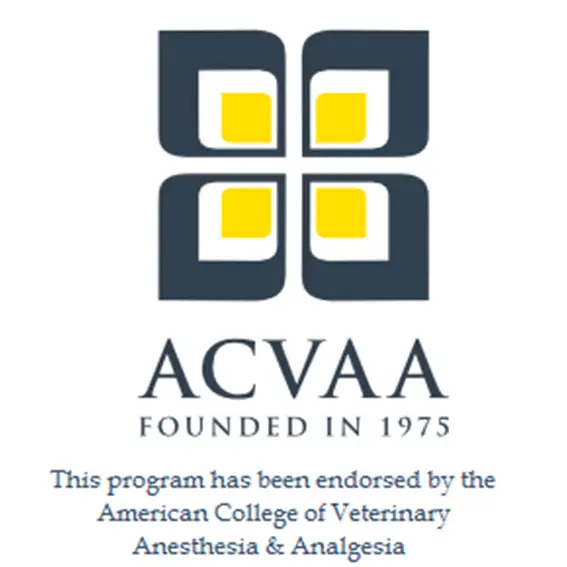
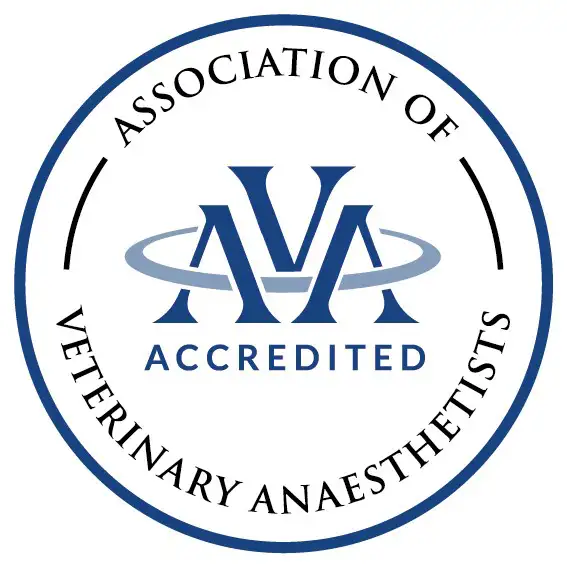
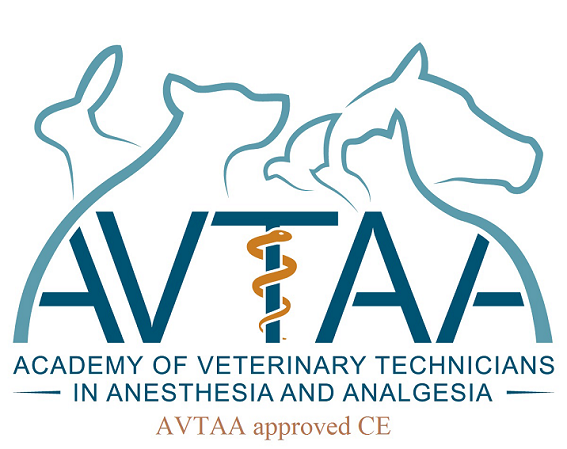

Upcoming courses
TFA
Auffrischerkurs zur Narkoseversorgung und Schmerztherapie bei kleinen Haustieren
TFA
Kleintieranästhesie-Zertifikats-Lehrgang für Tiermedizinische Fachangestellte
